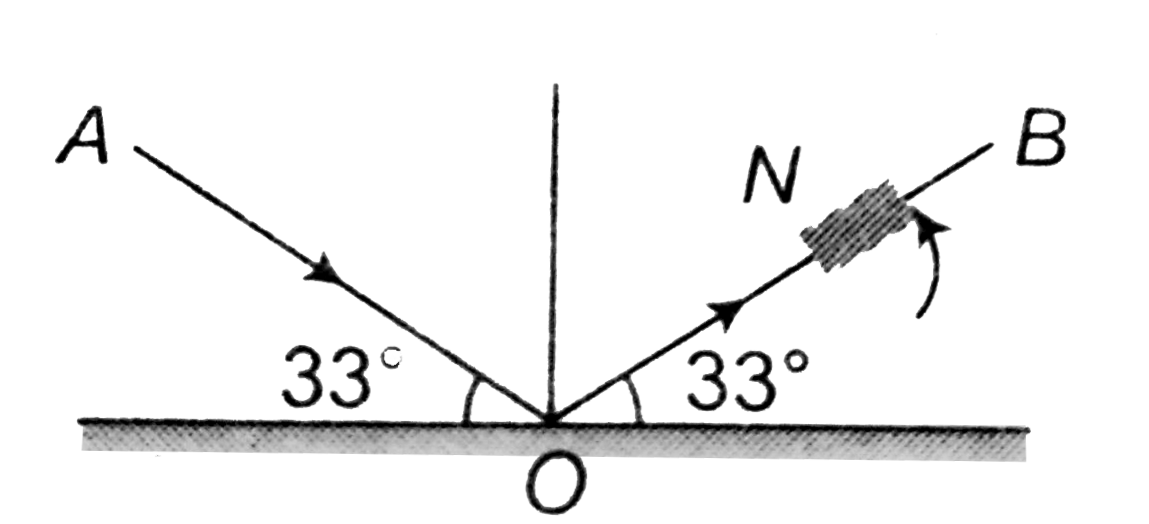A beam of light is incident on a glass slab (μ=1.54) in a direction as shown in the figure. The reflected light is analysed by a polaroid prism. On rotating the polaroid, (tan57∘=1.54)
(##DPP_PHY_CP24_E01_002_Q01.png" width="80%">
the intensity remains unchanged
the intensity is reduced to zero and remains at zero
the intensity gradually reduces to zero and then again increase
the intensity increases continuously
The correct Answer is:C
Here Angle of incidence, i = 57
tan57∘=1.54
uglass=tani
It means, Here Breswster.s law is followed and the reflected ray is completely polarised.
Now, when reflected ray is analysed through a polaroid then intensity of light is given by malus law.
i.e. I=I0cos2θ
on rotating polaroid .θ. changes. Due to which intensity first decreases and then increases.
Topper's Solved these Questions
- BOOK - DISHA PUBLICATIONCHAPTER - WAVE OPTICSEXERCISE - EXERCISE-2 : CONCEPT APPLICATOR30videos
WAVE OPTICS
- BOOK - DISHA PUBLICATIONCHAPTER - WAVE OPTICSEXERCISE - EXERCISE-2 : CONCEPT APPLICATOR30videos
WAVE OPTICS
- BOOK - DISHA PUBLICATIONCHAPTER - THERMODYNAMICS EXERCISE - EXERCISE -2 : CONCEPT APPLICATOR29videos
THERMODYNAMICS
- BOOK - DISHA PUBLICATIONCHAPTER - WAVESEXERCISE - EXERCISE -2 CONCEPT APPLICATOR30videos
WAVES
Similar Questions
A light beam is incident on a rectangular glass plate (μ=1.54) The reflected light OB passes through a nicol prism.
On observing the transmitted light while rotating the prism, it is seen that
 View Solution
View SolutionThe perimeter of the triangle shown in figure. is
(##NCERT_EXM_MAT_VI_C07_E01_015_Q01.png" width="80%">View Solution
Knowledge Check
- Question 1 - Select One
A beam of light AO is incident on a glass slab (μ=1.54) in a direction as shown in figure. The reflected ray OB is passed throught a Nicol prism. On viewinf through a Nicole prism, we find rotating the prism that (tan−11.54=57∘)
 Athe intensity is reduced down to zero and remains zeroBthe intensity reduces down some what and rises againCthere is no change in intensityDthe intensity gradually reduces to zero and then again increases
Athe intensity is reduced down to zero and remains zeroBthe intensity reduces down some what and rises againCthere is no change in intensityDthe intensity gradually reduces to zero and then again increases - Question 2 - Select One
In the figure shown
(##AHT_PGT_PHY_C10_E01_006_Q01.png" width="80%">AP>P0BP<P0CP=P0DP=0 - Question 3 - Select One
A beam of light AO is incident a glass slab (μ=1.54) in the direction show. The reflected ray OB is passed through a Nicol prism. On viewing through a Nicol prism, we find on rotating the prism that
 Athe intensity is reduceed down to zero and remains zeroBthe intensity reducees down somewhat and rises againCthere is no change in intensityDthe intensity gradually reduces to zero and then again increases
Athe intensity is reduceed down to zero and remains zeroBthe intensity reducees down somewhat and rises againCthere is no change in intensityDthe intensity gradually reduces to zero and then again increases
If unpolarized light falls on a glass plate (μ=1.54) at an incidence angle of 57∘, the reflected light is
View SolutionIf unpolarized light falls on a glass plate (μ=1.54) at an incidence angle of 57∘, the reflected light is
View SolutionAn unpolarised light is incident upon a glass plate of refractive index 1.54 at Brewster's angle and gets completely plane polarised. The angle of polarisation is (given tan 57∘ = 1.54)
View SolutionThe IUPAC name of (##GRB_ORG_CHM_P1_C03_E03_046_Q01.png" width="80%">
View SolutionFind out the correctly matched option:
(##AGP_EDG_BIO_XII_T1_SQP_08_E01_004_Q01.png" width="80%">View Solution

